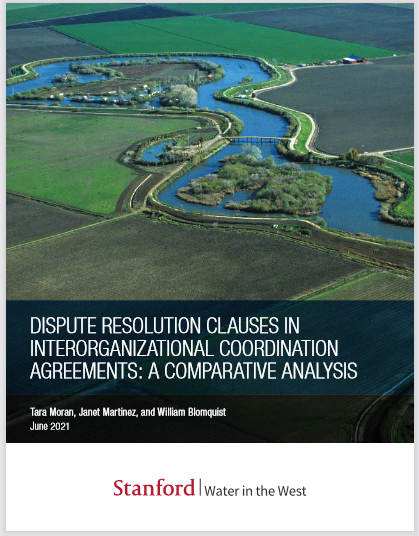 Adoption of California’s Sustainable Groundwater Management Act (SGMA) in 2014 posed a major coordination challenge for diverse public agencies by requiring them to align their activities at the scale of groundwater basins, which is not how most governing bodies are organized. Meeting this requirement meant establishing governing and operating relationships between agencies. Such interorganizational relationships (IORs) are essential in many fields, but are also prone to conflict. Understanding the factors affecting the inclusion, specificity and salience of dispute resolution clauses (DRCs) in interorganizational agreements ensures the long-term functionality of IORs.
Adoption of California’s Sustainable Groundwater Management Act (SGMA) in 2014 posed a major coordination challenge for diverse public agencies by requiring them to align their activities at the scale of groundwater basins, which is not how most governing bodies are organized. Meeting this requirement meant establishing governing and operating relationships between agencies. Such interorganizational relationships (IORs) are essential in many fields, but are also prone to conflict. Understanding the factors affecting the inclusion, specificity and salience of dispute resolution clauses (DRCs) in interorganizational agreements ensures the long-term functionality of IORs.
We examined 74 multi-entity agreements forming new quasi-voluntary local agencies, devoted to developing and implementing groundwater sustainability plans to achieve groundwater sustainability under SGMA. Statistical analyses were performed to identify potential factors influencing both the inclusion of DRCs in agreements, as well as the degree of specificity. Agency annual operating budgets and the use of facilitation services during agreement formation were statistically significant factors in predicting the inclusion of DRCs in agreements. Interviews were conducted with a subset of agency representatives, facilitators and lawyers to understand factors motivating the inclusion of DRCs and the salience of those clauses.
We found a near uniform lack of salience associated with the DRCs. While DRCs are considered an important component of multientity agreements, their inclusion and specificity are often driven by agreement drafters with minimal involvement of agreement parties impacting the salience of DRCs and potentially their use long-term.
Click here to read this report from Stanford’s Water in the West.

